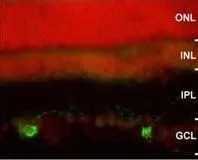
IHC analysis of rat retinal ganglion cells using GTX19383 Melanopsin antibody.
Melanopsin antibody
GTX19383
ApplicationsImmunoFluorescence, Western Blot, ImmunoCytoChemistry, ImmunoHistoChemistry, ImmunoHistoChemistry Frozen
Product group Antibodies
ReactivityHuman, Mouse, Rodent, Rat
TargetOpn4
Overview
- SupplierGeneTex
- Product NameMelanopsin antibody
- Delivery Days Customer9
- Antibody SpecificityThis antibody can detect over-expressed melanopsin protein but it does not work well on endogenously expressed protein.
- Application Supplier NoteWB: 0.1 - 0.2 microg/ml. ICC/IF: 5 microg/ml. IHC-Fr: 1:1000. *Optimal dilutions/concentrations should be determined by the researcher.Not tested in other applications.
- ApplicationsImmunoFluorescence, Western Blot, ImmunoCytoChemistry, ImmunoHistoChemistry, ImmunoHistoChemistry Frozen
- CertificationResearch Use Only
- ClonalityPolyclonal
- Concentration1 mg/ml
- ConjugateUnconjugated
- Gene ID192223
- Target nameOpn4
- Target descriptionopsin 4
- Target synonymsmelanopsin
- HostRabbit
- IsotypeIgG
- Protein IDQ8R456
- Protein NameMelanopsin
- Scientific Descriptionvisual pigment of phototransducing retinal ganglion cells involved in setting the circadian clock [RGD, Feb 2006]
- ReactivityHuman, Mouse, Rodent, Rat
- Storage Instruction-20°C or -80°C,2°C to 8°C
- UNSPSC12352203
References
- Retbindin mediates light-damage in mouse retina while its absence leads to premature retinal aging. Fan J et al., 2021 Aug, Exp Eye ResRead more
- Premacular Cells as Source of Neurotrophic Factors in Idiopathic Macular Holes. Vogt D et al., 2020 Nov, Curr Eye ResRead more
- Premacular Cell Proliferation Profiles in Tangential Traction Vitreo-Maculopathies Suggest a Key Role for Hyalocytes. Schumann RG et al., 2019, OphthalmologicaRead more
